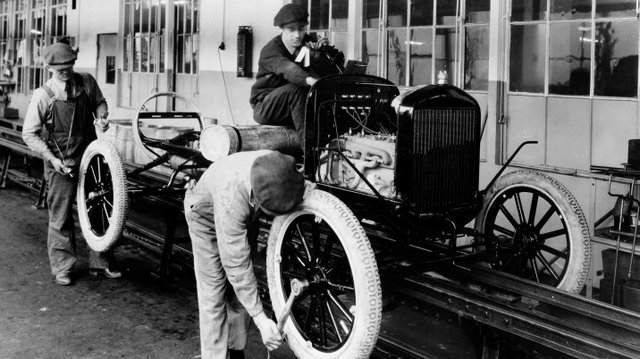One hundred years ago the Model T was taking over US roadways. Ford Motor Company's Model T remains the eighth best-selling car of all time, and no car released in the last 87 years has been able to knock it from the top ten. Ford changed the way we lived and related with technology by building the very first assembly line building the first super-affordable cars. Right?
Like every legendary American, myths have grown up around Ford and his famous Tin Lizzy over the years. Some of the basics facts you thought you knew about the Model T aren't facts at all.
The Model T Came In Any Color, So Long As It Was Black
Ford wrote in his autobiography that, "Any customer can have a car painted any color that he wants so long as it is black". But black wasn't a color option in the first four years of production. In the early days you could get grey, red, blue or green depending on the bodystyle. In 1910 Ford Motor began to use a standard paint color, a very dark shade of green known as Brewster Green. A very dark blue followed. It wasn't until 1913 that the company settled on black. Model T sales exploded in 1916 and so the vast majority of Model Ts on the road by 1920 were black.
By 1926 all the colors were once again offered to the public as a way to drum up interest in the failing brand. By that time production ended in 1927 you could get the T in five colors, but it was so old-fashioned that a driver needed a special license to operate it.
Ford Invented Building Cars On Assembly Lines
Ford Motor Co. may have built an impressive, even revolutionarily, fast and efficient assembly line, but it wasn't the first to turn out cheap cars. From the very early days of automotive manufacturing the Benz company in Germany used line production to build hundreds of cars a year.
By 1900 Benz was the largest producer of cars in the world. Then in 1901 Ransom E Olds used the technique at Olds Motor Works to build the first Oldsmobile in Lansing, MI. Olds sold cars for $650 a piece, far cheaper than any other car produced before.
Ford Paid Employees Enough To Purchase The Cars They Built
If he didn't build the first assembly line, or the first affordable car, what made Ford, well, Ford? In the end it was speed of production and the five-dollar-day that made him famous. In the hindsight of history, Ford seems to be social engineering the middle class.
Obviously, a hike in pay benefits workers, and that allowed many to buy Model Ts, but it wasn't out of the kindness of his industrialist heart that he raised wages. He paid what he did because the turn over in his early plants was so high. Building cars on the line was, and still is, repetitive and dangerous hard work. Line workers would sometimes simply walk away from their post, unable to stand the monotony and poor working conditions. In 1913, Ford needed to hire 52,000 employees for a 14,000-man operation. It made more sense to double wages from an already generous $2.25 an hour, than to keep hiring and training new, unreliable workers.
Henry Ford Designed The Model T
Behind every great historical figure there is an army of people forgotten along the way. Though Ford worked on many of his early automobile designs, the Model T wasn't one of them.
Ford's famous Tin Lizzy was designed by Hungarian immigrant Józef Galamb and Danish-born Charles Sorenson in 1907. The two were very close to Ford, each having taken on multiple roles in the very early days of the company. Galamb is also credited as a co-creator of the moving assembly line. Sorenson was known as "Henry Ford's Man" and stayed with the company for it's rise throughout the glory days of the 1950s.
Ford Was So Miserly He Scavenged Junkyards For Model T Parts For Use In Production
Rumor had it that Ford would send agents into junkyards to retrieve used parts and install them in new models to save money. The source of this rumor seems to be an unverified anecdote, which first showed up in Zoologist Nicholas Humphrey's 1976 paper The Social Functions of Intellect. He said Ford would send agents into junkyards looking over the parts in old Model Ts to find those that never failed. Almost all of the parts were found broken beyond repair. Except the kingpins, which looked brand new in almost every junkyard Model T. Instead of taking pride in the well-built kingpins he declared that they should be made cheaper to save time and money.
The story was most likely made up by Humphrey to better illustrate the theory of the efficiency of resource allocation by natural selection. The metaphor caught the attention of popular science writers like Richard Dawkings and Jared Diamond. Slowly, the story has been folded into the popular imagination of who Henry Ford was.
Nouvelles connexes



